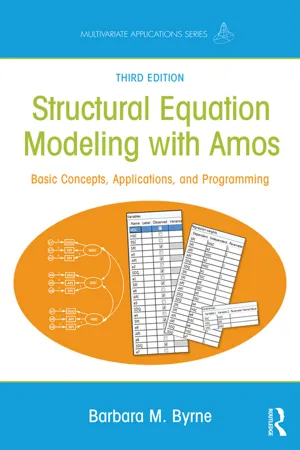
Structural Equation Modeling With AMOS
Basic Concepts, Applications, and Programming, Third Edition
- 438 pages
- English
- ePUB (mobile friendly)
- Available on iOS & Android
Structural Equation Modeling With AMOS
Basic Concepts, Applications, and Programming, Third Edition
About this book
This bestselling text provides a practical guide to structural equation modeling (SEM) using the Amos Graphical approach. Using clear, everyday language, the text is ideal for those with little to no exposure to either SEM or Amos. The author reviews SEM applications based on actual data taken from her own research. Each chapter "walks" readers through the steps involved (specification, estimation, evaluation, and post hoc modification) in testing a variety of SEM models. Accompanying each application is: an explanation of the issues addressed and a schematic presentation of hypothesized model structure; Amos input and output with interpretations; use of the Amos toolbar icons and pull-down menus; and data upon which the model application was based, together with updated references pertinent to the SEM model tested.
Thoroughly updated throughout, the new edition features:
- All new screen shots featuring Amos Version 23.
- Descriptions and illustrations of Amos' new Tables View format which enables the specification of a structural model in spreadsheet form.
- Key concepts and/or techniques that introduce each chapter.
- Alternative approaches to model analyses when enabled by Amos thereby allowing users to determine the method best suited to their data.
- Provides analysis of the same model based on continuous and categorical data (Ch. 5) thereby enabling readers to observe two ways of specifying and testing the same model as well as compare results.
- All applications based on the Amos graphical mode interface accompanied by more "how to" coverage of graphical techniques unique to Amos.
- More explanation of key procedures and analyses that address questions posed by readers
- All application data files are available at www.routledge.com/9781138797031.
The two introductory chapters in Section 1 review the fundamental concepts of SEM methodology and a general overview of the Amos program. Section 2 provides single-group analyses applications including two first-order confirmatory factor analytic (CFA) models, one second-order CFA model, and one full latent variable model. Section 3 presents multiple-group analyses applications with two rooted in the analysis of covariance structures and one in the analysis of mean and covariance structures. Two models that are increasingly popular with SEM practitioners, construct validity and testing change over time using the latent growth curve, are presented in Section 4. The book concludes with a review of the use of bootstrapping to address non-normal data and a review of missing (or incomplete) data in Section 5.
An ideal supplement for graduate level courses in psychology, education, business, and social and health sciences that cover the fundamentals of SEM with a focus on Amos, this practical text continues to be a favorite of both researchers and practitioners. A prerequisite of basic statistics through regression analysis is recommended but no exposure to either SEM or Amos is required.
Frequently asked questions
- Essential is ideal for learners and professionals who enjoy exploring a wide range of subjects. Access the Essential Library with 800,000+ trusted titles and best-sellers across business, personal growth, and the humanities. Includes unlimited reading time and Standard Read Aloud voice.
- Complete: Perfect for advanced learners and researchers needing full, unrestricted access. Unlock 1.4M+ books across hundreds of subjects, including academic and specialized titles. The Complete Plan also includes advanced features like Premium Read Aloud and Research Assistant.
Please note we cannot support devices running on iOS 13 and Android 7 or earlier. Learn more about using the app.
Information
Table of contents
- Cover Page
- Half-Title Page
- Seies Page
- Title Page
- Copyright Page
- Brief Contents
- Table of Contents
- Preface
- Acknowledgments
- About the Author
- Section I: Introduction
- Section II: Single-Group Analyses
- Section III: Multiple-Group Analyses
- Section IV: Other Important Applications
- Section V: Other Important Topics
- References
- Author Index
- Subject Index